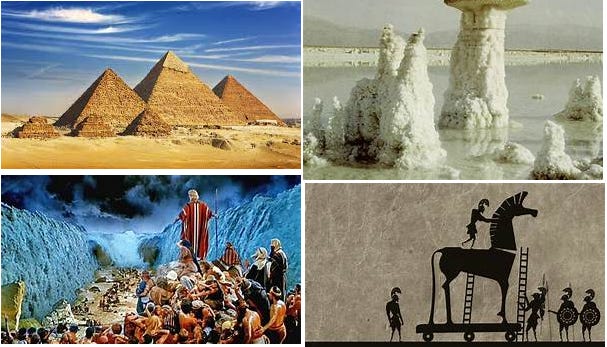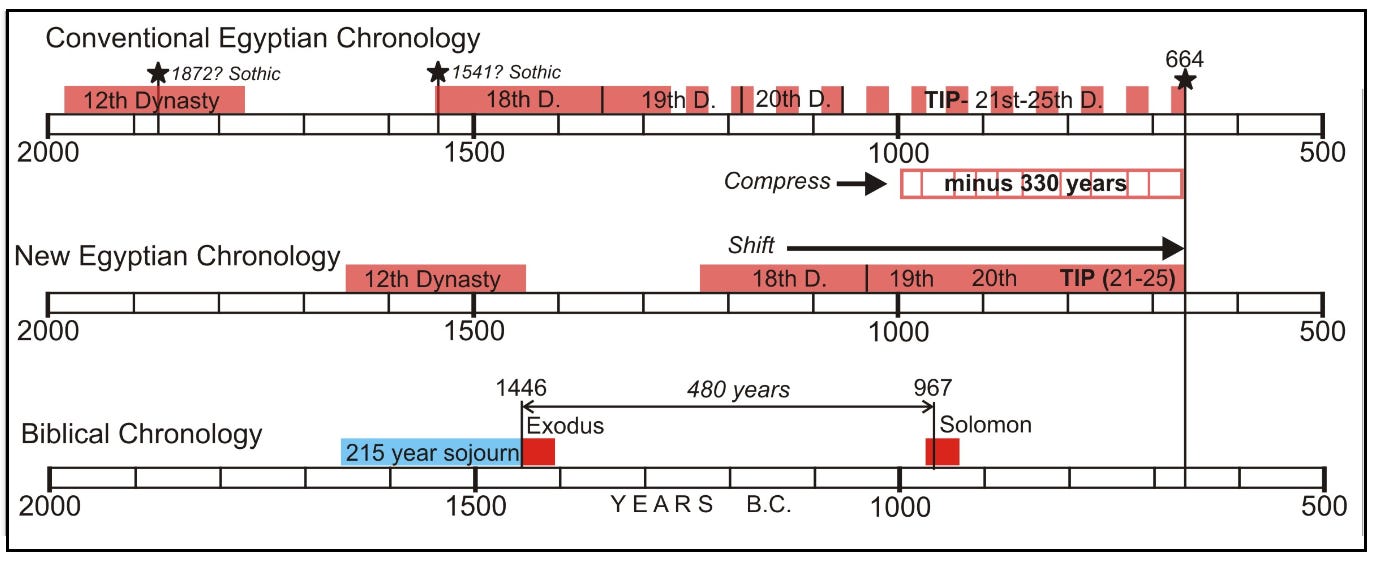Giza - Sodom & Gomorrah - Exodus - Trojan War
DAVID ROHL’S CHRONOLOGY
I think the first chart below compares David Rohl’s New Chronology with the mainstream’s Egyptian Chronology. The old chronology needs to be reduced by 330 years or so, putting the Exodus in the late 12th Dynasty at 1446 BC. Only the period from 2000 BC to 500 BC is covered.
Ancient Exodus https://ancientexodus.com/the-date-of-the-exodus/
The next chart covers the period from 3200 BC to 0 BC, but I start it at 3300 BC, the time of the Great Flood according to the Septuagint Bible. In the lower half of the chart I add red triangles to show the Great Flood at 3300 BC, the Y.D. Flood at 2600 BC and the Tower of Babel event at 2300 BC, which was also possibly the time of another tsunami flood which flooded Giza, called the First Intermediate Period. I show the 1st Dynasty starting about 2500 BC, so the Giza pyramids were built before that and they got flooded about the time of the Tower of Babel. Joseph became vizier in Egypt about 1670 BC. The Exodus occurred about 1446 BC. The Hyksos ruled Egypt after the Pharaoh’s army drowned. They were forced out about 150 years later, maybe with the help of Israel’s King Saul. The Hyksos were called the Philistines in the Bible. I show David in the chart after Moses at the bottom. He was King from about 1010 BC. The Trojan War occurred about 850 BC. I discuss below a video with David Rohl to provide more details.
Before I get to the video, here’s David Rohl’s more detailed chronology. https://en.wikipedia.org/wiki/New_Chronology_%28Rohl%29
VIDEO: David Rohl: Greek Dark Age, Hyksos Invasion and Sea Peoples youtube.com/watch?v=plGmRWIlM38
Khufu, Khafre and Menkare ruined the economy by building huge pyramids in the 1st Dynasty, so Egypt could not afford to build huge pyramids after that. The Great Pyramids were tombs later ransacked by the Hyksos.
Joseph under Amenemhat III was 216 years before the Exodus. Joseph probably designed the Labyrinth of Egypt.
Israelites were in Egypt 250 years from the end of the 12th Dynasty to the end of the 13th. At Avaris were likely Hebrew slaves.
Ancient Egyptians lived mostly no longer than age 35.
The Bible says the Exodus was in 1446BC. The Hyksos invaded Egypt during the Exodus at time of Pharaoh Tutimaos or Dudimose. The Hyksos oppressed Egypt for 150 years, in the 2nd Intermediate Period of Egypt. Then the Thebans pushed them out and they then became known as the Philistines of the Bible.
Jericho was destroyed at the end of the Middle Bronze Age.
Ramses was c. 979 BC.
Flinders Petrie found Mycenaean pottery at Tell El Amarna that matched the pottery at Mycenae. Letters in the British Museum were written by King Saul to Pharaoh Akhenaten. Saul's real name was Labaya. Solomon's real name was Jedidiah. Solomon's Temple was built {c. 926BC} 480 years after the Exodus.
Babylonian chronology goes back to c. 911BC without interruption.
The Trojan War is dated to 1177 BC, but was really 300 years later. After the Trojan War there was no 300 year Dark Age. The Mycenaean collapse wasn't followed by a 300 year Dark Age. The Mycenaeans returned to Greece after the Trojan War, then the Dorians invaded Greece and burned their cities. Homer didn't tell the story of Troy 300 years after the War, but soon after it. The collapse only lasted 40 years at most when Greece rebuilt.
The Sea People were {Mycenaeans} migrating after the Trojan War chaos. King Mapsos of Anatolia, from the time of the Trojan War, was likely one of the leaders of the Sea People killed by the Egyptians. When they failed to conquer Egypt, they went to southern Europe. Shardana (Sea People) were from Sardis on Anatolia. Some migrated to Italy and became known as Etruscans. Some migrated to Sardinia. Other Sea People, with Aeneas, founded Carthage in 825 BC. His wife, Dido, came from Tyre. Other Phoenicians, like Dido, also migrated west at the same time as the Greeks. Aeneas also went to Lavina, Italy, where the Roman kings came from. Julius Caesar was Ilios. His ancestors came from Troy/Ilios.
21st Dynasty Kings collected all previous kings' mummies and hid them in a safe cache, because tomb robbers had started getting into their tombs. These later Kings also stripped many of the valuables from the mummies.
Wikipedia’s Ancient History Timeline
These dates are off by quite a bit. They’re about 700 years too old. Maybe I’ll fix the dates some day.
c. 3200 BCE: Sumerian cuneiform writing system[1] and Egyptian hieroglyphs are first used
3200 BCE: Cycladic culture in Greece
3200 BCE: Caral-Supe civilization begins in Peru
3200 BCE: Rise of Proto-Elamite Civilization in Iran
3150 BCE: First Dynasty of Egypt
3200 BCE: Skara Brae is built in Scotland
c. 3000 BCE: Stonehenge construction begins. In its first version, it consisted of a circular ditch and bank, with 56 wooden posts.[2]
c. 3000 BCE: Cucuteni–Trypillia culture is established in Romania and Ukraine.
3000 BCE: Jiroft culture begins in Iran
3000–2500 BCE: Earliest evidence of autochthonous iron production in West Africa.[3]
3000–2300 BCE: The East African Pastoral neolithic culture builds East Africa's earliest and largest monumental cemetery at Lothagam North Pillar Site.[4]
3000 BCE: Domestication of the horse in the Yamnaya culture.
2800 BCE: Kot Diji phase of the Indus Valley Civilisation begins
2800 BCE: Longshan culture begins in China
2700 BCE: Minoan civilization ancient palace city Knossos reaches 80,000 inhabitants
2700 BCE: Rise of Elam in Iran.
2700 BCE: The Old Kingdom begins in Egypt.
2600 BCE: Oldest known surviving literature: Sumerian texts from Abu Salabikh, including the Instructions of Shuruppak and the Kesh temple hymn.
2600 BCE: Mature Harappan phase of the Indus Valley civilization (in present-day Pakistan and India) begins
2600 BCE: Emergence of Mayan culture in the Yucatán Peninsula
2560 BCE: King Khufu completes the Great Pyramid of Giza. The Land of Punt in the Horn of Africa first appears in Egyptian records around this time.
2500–1500 BCE: Kerma culture begins in Nubia
2500 BCE: The last mammoth population, on Wrangel Island in Siberia, goes extinct.
2492 BCE: Traditional date for the legendary foundation of Armenia by Hayk.
2334 or 2270 BCE: Akkadian Empire is founded, dating depends upon whether the Middle chronology or the Short chronology is used
2250 BCE: Oldest known depiction of the Staff God, the oldest image of a god to be found in the Americas
2200–2100 BCE: 4.2-kiloyear event: a severe aridification phase, likely connected to a Bond event, which was registered throughout most of North Africa, Middle East and continental North America. Related droughts very likely caused the collapse of the Old Kingdom in Egypt and the Akkadian Empire in Mesopotamia
2200 BCE: completion of Stonehenge
2055 BCE: The Middle Kingdom begins in Egypt
1900 BCE: Erlitou culture begins in China
1800 BCE: Alphabetic writing emerges
1800 BCE: The Old Babylonian text of the Epic of Gilgamesh is written. Possibly the oldest significant work of literature
1780 BCE: Oldest Record of Hammurabi's Code.
1700 BCE: Indus Valley Civilization comes to an end but is continued by the Cemetery H culture; The beginning of Poverty Point culture in North America
1600 BCE: Minoan civilization on Crete is destroyed by the Minoan eruption of Santorini island
1600 BCE: Mycenaean Greece
1600 BCE: The beginning of Shang dynasty in China, evidence of a fully developed writing system, see Oracle bone script
1600 BCE: Beginning of Hittite dominance of the Eastern Mediterranean region
c. 1550 BCE: The New Kingdom begins in Egypt
1500 BCE: Composition of the Rigveda is completed
1700–1400 BCE: The Proto-Sinaitic script is the oldest alphabet created in Egypt.
c. 1400 BCE: Oldest known song with notation
1400–400 BCE: Olmec civilization flourishes in Pre-Columbian Mexico, during Mesoamerica's Formative period
1200 BCE: The Hallstatt culture begins
1200–1150 BCE: Bronze Age collapse occurs in Southwestern Asia and in the Eastern Mediterranean region. This period is also the setting of the Iliad and the Odyssey epic poems (which were composed about four centuries later).
c. 1180 BCE: Disintegration of Hittite Empire
1100 BCE: Use of Iron spreads.
1050 BCE: The Phoenician alphabet is created
1046 BCE: The Zhou force (led by King Wu of Zhou) overthrow the last king of Shang dynasty; Zhou dynasty established in China
1000 BCE: Nok culture begins in West Africa
1000 BCE: The second stream of Bantu expansion reaches the great lakes region of Africa, creating a major population centre.[5][6]
890 BCE: Approximate date for the composition of the Iliad and the Odyssey
814 BCE: Foundation of Carthage by the Phoenicians in today known Tunisia
800 BCE: Rise of Greek city-states
788 BCE: Iron Age begins in Sungai Batu (Old Kedah)
c. 785 BCE: Rise of the Kingdom of Kush






